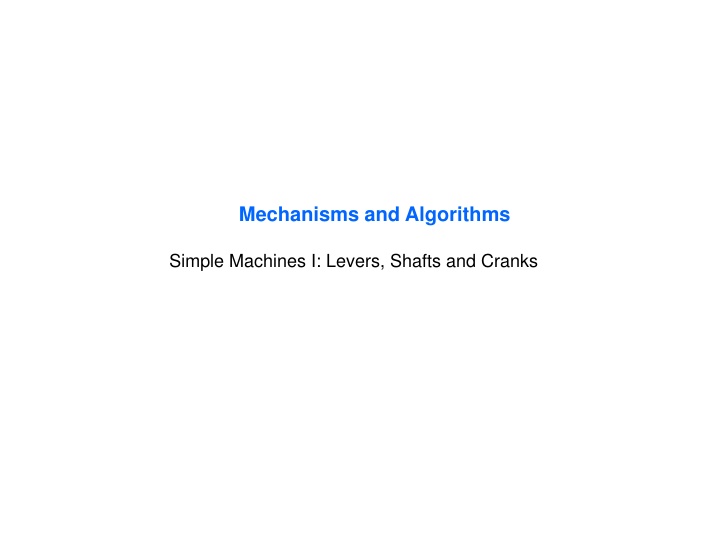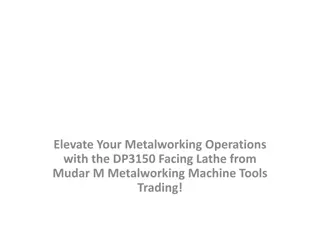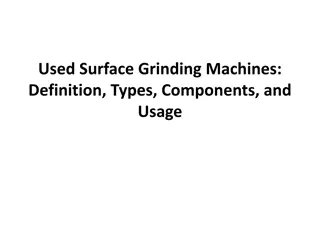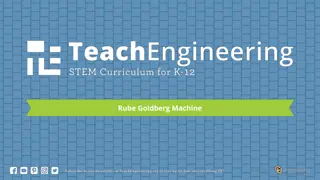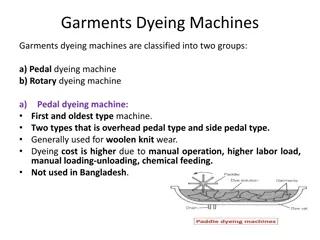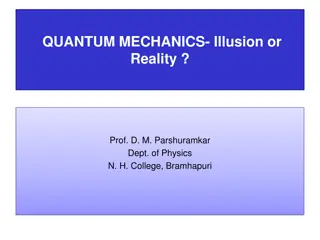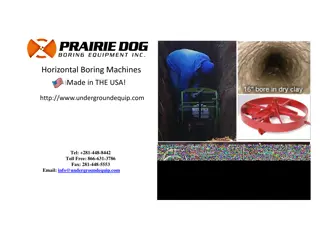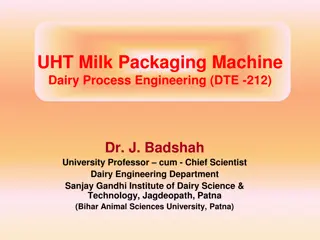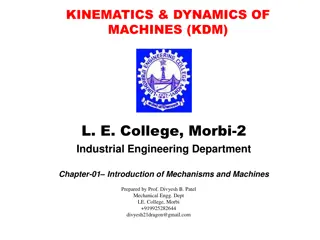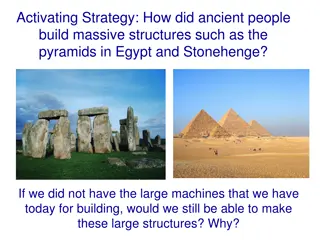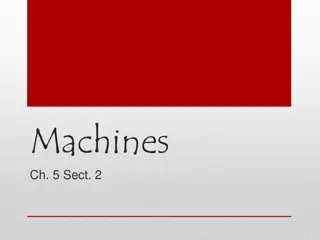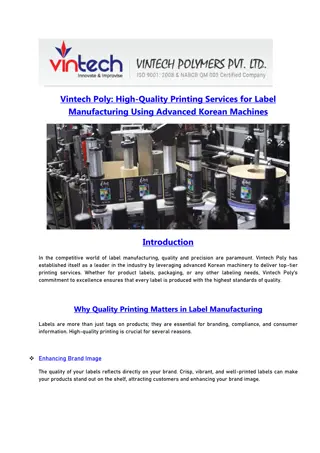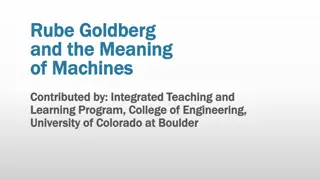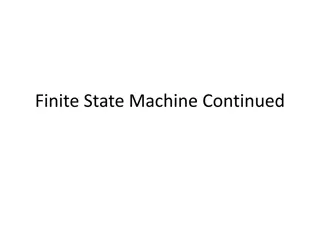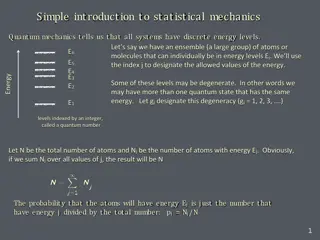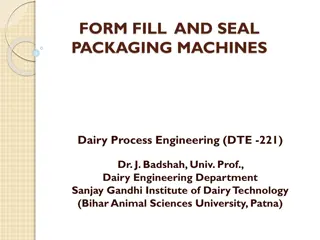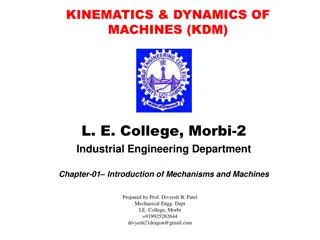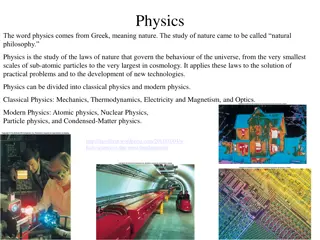Simple Machines and Mechanics
Fascinating world of mechanisms and algorithms, delving into the principles of levers, shafts, and cranks. Discover the historical origins of automata and the fundamental laws of motion established by pioneers like Archimedes, Galileo, and Newton. Unveil the secrets behind the intricate mechanical movements showcased in books and creations like "Cabaret Mechanical Movement" and "Anubis." Learn about the basic mechanisms that underpin all mechanical systems and how they shape the study of mechanical engineering.
Download Presentation

Please find below an Image/Link to download the presentation.
The content on the website is provided AS IS for your information and personal use only. It may not be sold, licensed, or shared on other websites without obtaining consent from the author.If you encounter any issues during the download, it is possible that the publisher has removed the file from their server.
You are allowed to download the files provided on this website for personal or commercial use, subject to the condition that they are used lawfully. All files are the property of their respective owners.
The content on the website is provided AS IS for your information and personal use only. It may not be sold, licensed, or shared on other websites without obtaining consent from the author.
E N D
Presentation Transcript
Mechanisms and Algorithms Simple Machines I: Levers, Shafts and Cranks
Cabaret Mechanical Movement By Aidan Lawrence Onn and Gary Alexander Excellent reference book Lectures reference figures from this book Good concept book but no kinematic synthesis Wood and paper, but not Lego
Some Principles History of Automata circa 500 BC Movements of today s machines (e.g. industrial robots) still use same mechanisms Observations: Appearances can be deceptive. Motion is not always obvious Explain how this works http://www.youtube.com/watch?v=YFqkKn9PgNg Anubis by Paul Spooner and Matt Smith Hands are fixed to the floor Lever: Feet (load), Pivot (fulcrum), Effort (Connecting Rod) Effort generated by Crank and Connecting Rod Effort acts on feet thus appears Anubis is doing push-ups
Body moves vertically on shafts Body rests on cam Rotating crank, rotates cam Appears that fish undulating http://www.youtube.com/watch?v=ClQyF_4bTy0 Wriggling Fish by Jan Zalud Explain how this works Turning handle causes man s head to turn side-to-side Birds just rotate If you want to make things move, spend time studying how other things move Birdwatcher by Peter Markey
Machines: A machine is something that modifies force Input is when force comes from an outside source The mechanical action of the machine produces output Q1: What is the input? A1: Legs pushing on pedals Q2: What is the output? A2: Wheel rotation Mechanics: The study of the motions and forces that occur between input and output
Mechanics: Origins trace back to ancient Egypt Archimedes: first recorded scientific foundations for mechanics circa 3rd BC Archimedes: formulas for equilibrium of simple levers and centers of gravity Galileo: circa 1564 used mathematics to solve physical problems Galileo advanced Archimedes work and developed the science of Dynamics Newton: circa 1642 developed the 3 laws of motion Law 1: motion does not require force; force only needed to accelerate motion Law 2: the greater the force, the greater the acceleration Law 3: action and reaction; if object pushed, it will push equally in opposite direction All mechanical systems are made from combining 5 basic ones: Inclined Plane (or slope) Wedge Screw Lever Wheel But Wedge is 2 inclined planes joined together Screw is inclined plane wrapped around shaft Wheel is a lever that rotates 360 degrees Thus: Only lever and inclined plane are really the only 2 basic mechanisms
Levers All machines (almost) always employ at least one lever Lever of the First Order: Fulcrum is always between the load and the effort Can you think of examples? Mechanical Advantage Mechanical advantage is ratio of load versus effort Leverage is ratio distances of the effort and load to fulcrum Example Leverage is ratio of A and B = 6:2 = 3:1 Load Mechanical Advantage = Effort Thus, effort of 1 could move a load of 3
Lever of the Second Order: Load lies between fulcrum and the effort Can you think of examples? Also known as a force multiplier (having very good mechanical advantage) Effort must move greater distance than the load
Lever of the Third Order: Effort applied between fulcrum and load Can you think of examples? Human Arm: Fulcrum (elbow), Effort (bicep muscle attached to forearm, just below elbow), Load (held in hand) Ladder: Fulcrum (ground), Effort (person supporting ladder). Higher firefighter ascends, the greater the effort needed Fishing Rod: Fulcrum (left hand grasps bottom), Effort (right hand move rod up and down), Load (tackle, bait, fish) Also known as a force reducer (efforts always greater than load) Load moves faster than the effort (can call this a movement amplifier)
Shafts (and Bearings) Often, all mechanisms attach to the shaft (or axle). If not shaft not smooth, machine not smooth The Lion Tamer by Ron Fuller http://www.youtube.com/watch?v=zic2c080f_Y 1. The handle (or crank) 2. Eccentric cam (tamer stoops up and down) 3. Pin wheel (rotates tamer) 4. Snail cam (opens lion s mouth then snaps down) For sequence to remain constant, mechanisms are fixed to shaft so that lion s mouth is always open when the tamer s head is in lion s mouth
Shafts: Shafts can be anything: from stiff piece of wire or wooden dowel, to accurately engineered rod Part with hole that supports shaft is called the bearing Shaft must be strong enough to support mechanisms they carry Shaft must fit the bearings; not too tight (friction) or not too loose (wobble) Bearings: Bearing keeps the rotating shaft stable and running smoothly Must be chosen together with shaft Ball Bearings: Outer race is fixed while inner race rotates with shaft Balls roll with small contact area, hence friction is low Polished steel bearings help reduce friction too Simple Example Shaft passes through single bearing Shaft is attached to handle and a disc Off-center hole in disc will yield wobble Add second bearing for better support Add collars to prevent side-to-side movement
Snail Cam: Shafts don t only rotate in bearings Snail cam pushes shaft upwards Shaft also needs support of a bearing If bearing (hole) is too big, shaft moves off-center (jamming) If bearing too far from cam, then also jamming Add thickness to bearing Results in more predictable up-and-down movement of cam-follower Hole diameter: just big enough to allow free up-and-down movement Add U-shaped bracket Positions bearing as close as possible to end of shaft where cam pushes
Fixing: 1. Pin the cam: pin pushed through pre-drilled hole into the cam and the shaft 2. Cam with hub: Hub is part of the cam or glued to it. Screw passed through hub and into the shaft. This keeps the fixing away from the radial surface of the cam 3. Screwed cross pin: Similar to 2 but easier to make. A wire or split-pin passes through the shaft only. A screw in the cam holds it in place
Cranks A lever attached to a rotating shaft cranks convert rotation to reciprocation Crank: circular disk with a pin Pin: connected to a vertical rod (loose enough to allow crank to rotate) Rod: constrained by guides When shaft rotates, rod reciprocates (moves up and down) At 1 vertical rod at highest point At 3 vertical rod at lowest point CW rotation thru 360-degrees
Rotating shaft needs bearings on both sides of crank Arrows show throw of the crank Throw: diameter of the path crank travels Can add many cranks (but need more bearings) Offset cranks so at different positions at different times Above: one crank is down when other crank is up Crank rotation thru 360-degrees Crank pin (black) simply repeats motion of the handle
Using Cranks to Operate Levers As shaft rotates, crank will lift lever Lever traces a small arc Gravity keeps lever in contact with crank pin At 1 , lever is in lowest position At 3 , lever is in highest position Fast shaft rotation = lever breaks contact with crankshaft Lever may bounce (higher than expected) if struck hard Too little fall time when crankshaft at lowest position Any Possible Solutions? Crank rotation thru 360-degrees
Use a slot Lever is driven up and down by crank This positive connection doesn t depend on gravity Lever will always move through expected path Crank rotation thru 360-degrees
Jumping Nurse by Paul Spooner Loose joints (shoulders, elbows, etc) Crank and cam push her up Looseness provides joint movement Kissing Couple http://www.youtube.com/watch?v=3EJQcexRMig Handle rotates crank at back Crank at back connected to crank at the front Connecting piece has 2 slots to allow cranks to rotate What motion does the front crank follow? Dancing Girls by Peter Markey
